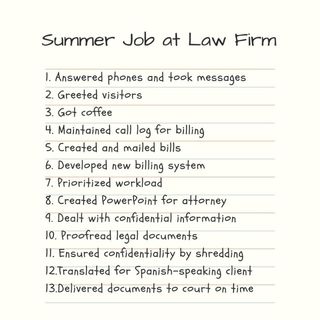Career
The Value of Keeping Track of What You Do at Work
It’s easy to forget important events that can lead to a better job.
Posted April 4, 2019
This is the third post in my series about deceptively simple lists that can boost your career. You can find my previous posts on the power of lists to identify who you are as well as a list that will help you determine if your current job still fits.
Today’s list is called “What I Do at Work.” Like the others, this list seems obvious and it also seems ripe for lots of silly entries like “endlessly search Twitter” or “drink a lot of coffee” so go ahead and have your fun. But you might be surprised by what you learn. When you’re ready, start your list by selecting a typical day. What do you do first when you arrive at work? Go through the day and—if needed—continue listing what you do on evenings or weekends if you work on projects after-hours. As you keep developing it (don’t be surprised if it takes multiple pages) you will see its power emerge. In addition, be sure to add unique experiences or events that aren’t part of your regular duties but demonstrate your skills. This could be anything from a special project you took on (from organizing a company event to preparing a technical document) or working with an especially difficult client.

Why is this list so important? Because we seldom take the time to think about what we actually do all day—and quite often, it’s more than we realize. We take so many activities for granted: work we do that seems second-nature to us but would actually be difficult for a new person in our role. And we quickly forget what we’ve done because we’re always focusing on what is next. (That’s why saving old “to-do” lists isn’t a bad idea.)
By reviewing all you do, you may be surprised at the list of accomplishments and talents you have uncovered. In fact, consider making sub-lists of the skills, talents, or personality traits needed to accomplish what you do. Those factors can be used to create great stories and examples for interviews.
Here are some other ideas for using this list:
- To bolster your resume and provide relevant examples of your work
- To update your LinkedIn account
- For considering new job opportunities by focusing on the tasks you have most enjoyed: why not find a job that lets you do more of what you enjoy and less of what you don’t?
- To provide evidence when asking for a raise: you really are doing a lot, aren’t you?
- To prove to a future employer you can succeed at a new position
Consider this list an ongoing document of your work—you might want to keep it as a Word doc on your computer screen so you remember to update it regularly.
One of my favorite uses of this list is when you want to transition to a new career. Even though your new career might not require the exact same activities, you can use what you have accomplished to shape your resume to fit the new career.
Here’s a sample list compiled by a college senior who had worked at a law firm over the summer. (A more extensive version of this list can be found in my book, "You Majored in What? Creating Your Path from College to Career.") He had already made the decision not to go to law school, so he was concerned that “nothing would be relevant” to employers from any other field. But when we looked at his list, we saw lots of potential resume bullet points that would interest employers outside the legal field. Take a look and see if you can spot his many talents that have nothing to do with the law.

He has skills in providing customer service, organizing his work, managing time, proofreading, basic office management, Spanish language ability, etc. He could even discuss his willingness to support others (“getting coffee”) even when the task is less than glamorous. Now he has a great list with a variety of items he can pull as needed to add to a resume. When he writes a targeted resume, he can pick and choose from this list to determine what he wants to share with a potential employer. He won’t put every activity on his resume; just the ones that are relevant to whatever position he is seeking. For instance, if the job he is seeking requires bilingual skills, his Spanish translation activity will rise to the first bullet-point in his resume. On the other hand, if he’s seeking a sales/marketing position, his work with PowerPoint, greeting customers, and maintaining detailed records might be what he will choose to highlight the position.
I hope with these three posts, you are starting to get a feel for the power of a simple list. Perhaps you have learned some new things about yourself or uncovered hidden interests or skills? Maybe you have been reminded of a long-forgotten skill, hobby or interest that you’d like to try again. Getting in the habit of making lists whenever you find yourself stuck or need to plan a future activity can provide an invaluable career boost.
© 2019 Katharine S. Brooks. All rights reserved.


